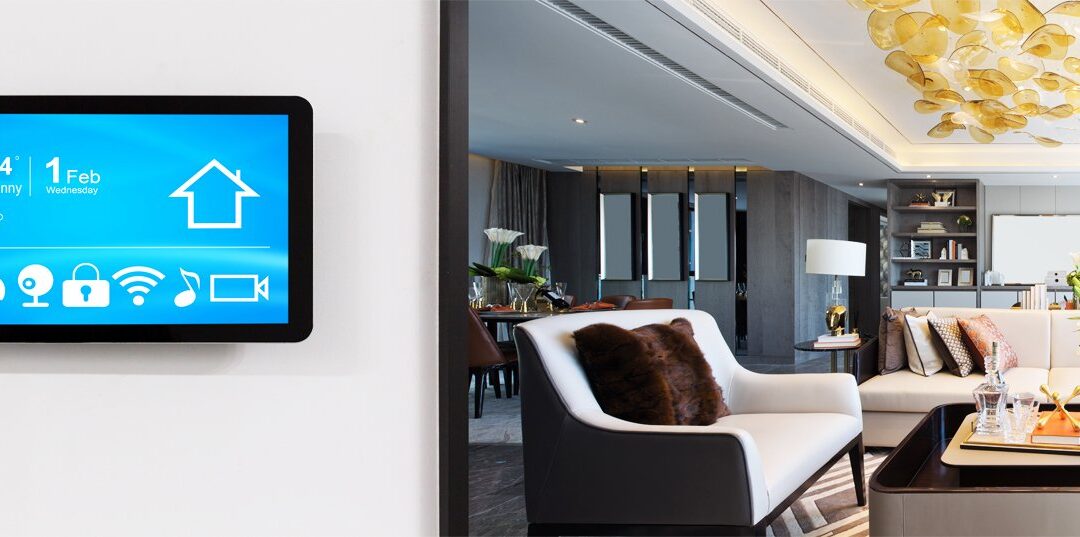A home with a computer-controlled automation system, which manages numerous home operations including lights and appliances, is referred to as a “smart home.” This system makes use of smart technology to network equipment, making it possible for users to access and use the appliances from anywhere on the network. According on predetermined criteria, the system can be used for monitoring, warning, and performing a variety of duties. Automatic communication is made possible by smart technology on fixed and mobile phones as well as the internet. Different electronics parts are used in smart technology to accomplish various tasks. The following broad categories are used to classify these elements:
- Interface:-These are the elements that facilitate user-system communication.
- Central unit:- used for programming and altering a system, a good example is a computer.
- Controller:- These elements base their decisions on events and preprogrammed rules.
- Actuator:- These parts carry out physical operations; automatic light switches, relays, and door and window openers are a few examples.
- Sensor:- to keep track of and report any modifications, Examples include temperature readings, heat and motion sensors, humidity sensors, and smoke detectors.
For a home to be deemed smart, the following issues must be addressed:
-Energy management
-Smart appliances
-Entertainment
-Emergency management
-Lighting system
-Security
Energy Management
Energy management is thought to be particularly effective in smart homes. For energy regulation, electronic equipment are installed in the home to track energy consumption and the number of occupants at any one moment. When no one is home, the thermostat is automatically reduced, and all of the lights and appliances that are not in use are switched off. The energy management system also makes energy-saving adjustments to the heating, cooling, and fan systems. A non-used outlet’s energy is also immediately turned off by the smart home energy system. When compared to a home where energy usage is managed manually, a smart home energy management system can save energy costs by up to 65%.
Smart Appliances
Installing smart appliances in a home makes it that much more technologically advanced. The system networks the appliances to carry out particular tasks at a precise moment. A coffee maker that can be operated remotely and prepares coffee just before the home’s owner awakes is an example of a smart device. When the coffee is ready, the coffee maker will sound an alarm to let the homeowner know. Based on the temperature of the food inside, a smart refrigerator automatically modifies the temperature inside. These technologically advanced appliances are linked to a computer, which controls their automatic on/off operation. People’s lives are calmer and more organized thanks to smart appliances, which also facilitate easier daily planning thanks to technology. People can focus on a particular activity more easily when there is peace since other tasks can be completed without constant supervision and involvement.
Entertainment
The functionality of home entertainment systems, including the TV and home theater system, can be controlled by smart entertainment systems. Users of smart TVs have the option to change channels by speaking into the device or using the internet to command the TV what to record and when. incredibly thin rear projections Digital Light Processing (DLP) has been used in the development of TVs, which have enormous screen sizes and are thin and light enough to hang on a wall. Smart home theater systems with internet access stream music from various PCs online and store it on internal hard drives. Virtually every feature of this home theater may be managed remotely via the internet.
Emergency Management
A smart home emergency system is made to alert residents when there is a situation that requires immediate attention while also contacting the appropriate authorities. For instance, if there is a fire, the central computer receives a signal from the fire detector, which sets off the alarm and dials the fire department at the same time. Another illustration is when there is a gas leak in the home. To stop a fire from starting, the emergency control system will turn off all electrical appliances and shut off the main gas supply. The device will then activate the alarm and transmit a notification of the gas leak to the home’s owner via a mobile phone or a personal computer over the internet.
Lighting system
By using programmable lights or lighting systems that can be accessed from a distance, smart homes use lighting systems to make their homes safer and easier to live in. The owner of the home can configure programmable lighting systems so that the lights turn on or off at particular times and even dim them based on the mood. Specific lights are turned on at specific times during the night by a central computer. This enhances security by discouraging criminal activity. Using mobile phones or PDAs, remote access allows for the remote control of lights from anywhere in or outside the home.
Security system
A smart home is far more secure than a traditional home since it is simple to defend and difficult to break into. A smart home has alarm systems that function similarly to automobile alarms. The home’s security system switched on security mode and closed all windows and doors on its own. When the home’s owner goes on a long trip or vacation, the smart home security system is set up for a single day of use or for a long period of time. In this instance, the security system is configured to open the curtains and turn on and off the lights to give the impression that someone is home.

